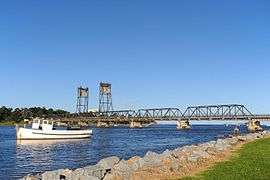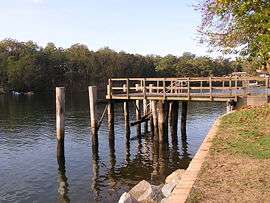Clyde River (New South Wales)
| Clyde River (Bhundoo[1]) | |
| "deep water "Yuin | |
| Open intermediate tide dominated drowned valley estuary;[2] or Perennial river[3] | |
 Clyde River flowing under the bridge at Batemans Bay | |
| Name origin: River Clyde, Scotland (1821)[3][4] | |
| Country | Australia |
|---|---|
| State | New South Wales |
| Regions | South East Corner (IBRA), South Coast |
| Local government areas | Shoalhaven, Eurobodalla |
| Tributaries | |
| - left | Claydons Creek, Pigeon House Creek, Boyne Creek, Cockwhy Creek |
| - right | Yadboro River, Crooked Creek (Clyde River)|Crooked Creek, Bimberamala River, Currowan Creek, Buckenbowra River |
| City | Batemans Bay |
| Source | Budawang Mountains, Great Dividing Range |
| - location | near Kangaroo Hill, within Budawang National Park |
| - elevation | 597 m (1,959 ft) |
| Mouth | Tasman Sea, South Pacific Ocean |
| - location | Batemans Bay |
| Length | 102 km (63 mi) |
| Depth | 3 m (10 ft) |
| Basin | 1,723 km2 (665 sq mi) |
| Area | 17.5 km2 (7 sq mi) |
| National parks | Budawang, Clyde |
| [3][5] | |
The Clyde River (Aboriginal: Bhundoo[1]) is an open intermediate tide dominated drowned valley estuary;[2] or perennial river[3] that flows into the Tasman Sea, located in the South Coast region of New South Wales, Australia.
Course and features
The Clyde River rises below Kangaroo Hill in the Budawang Range, part of the Great Dividing Range, within Budawang National Park, south of the locality of Sassafras, and flows generally southwards parallel to the east coast, joined by nine tributaries including the Bimberamala, Yadboro, and Buckenbowra rivers, before turning east and reaching its mouth of the Tasman Sea at Batemans Bay. The river descends 601 metres (1,972 ft) over its 102 kilometres (63 mi) course.[5]
The lower reaches of the Clyde River form a substantial estuary up to 30 kilometres (19 mi) from its mouth[1] which is navigable by small vessels to Nelligen, with a tidal ebb of up to 1.28 metres (4 ft 2 in). The coastal estuary covers a catchment area of 1,723 square kilometres (665 sq mi) and contains approximately 50,737 megalitres (1,791.8×106 cu ft) of water over an estimated surface area of 17.5 square kilometres (6.8 sq mi); and at an average depth of 3 metres (9.8 ft).[6]
The river is one of the last major rivers in eastern Australia that has not been dammed.[1]
In its upper reaches, the river forms within the Budawang National Park; while in its lower reaches, the river flows through the Clyde River National Park.
Water quality of the basin is very good. The upper catchment is heavily timbered (state forests and national parks); there is a small amount of logging in the Yadboro State Forest.[7] There are no polluting industries in its catchment, nor any sewage outflows, and thus the river has a reputation for the cleanest, least polluted waters of any major river in eastern Australia.[1]
Etymology
The river was known to Indigenous Australians as the Bhundo.
The river was named after the River Clyde in Glasgow, Scotland, by Lieutenant Robert Johnson who navigated the river aboard the cutter Snapper on 1 December 1821.[4][8]
Gallery
 Early morning mist on the Clyde River at Nelligen, 2008.
Early morning mist on the Clyde River at Nelligen, 2008. Clyde River, looking upstream from Batemans Bay towards the Budawang Range, 2009.
Clyde River, looking upstream from Batemans Bay towards the Budawang Range, 2009.- At Shallow Crossing, The River Road crosses the Clyde River at a concrete ford.
 Wharf at Nelligen formerly used by the Illawarra Steam Navigation Company.
Wharf at Nelligen formerly used by the Illawarra Steam Navigation Company.
See also
- Budawang Range
- Rivers of New South Wales
- List of rivers of New South Wales (A-K)
- List of rivers of Australia
References
- 1 2 3 4 5 "Bhundoo (The Clyde River)". Welcome to the Clyde Coast. www.clydecoast.com.au. Retrieved 14 January 2008.
- 1 2 Roy, P. S; Williams, R. J; Jones, A. R; Yassini, I; et al. (2001). "Structure and Function of South-east Australian Estuaries". Estuarine, Coastal and Shelf Science. 53: 351–384. doi:10.1006/ecss.2001.0796.
- 1 2 3 4 "Clyde River". Geographical Names Register (GNR) of NSW. Geographical Names Board of New South Wales. Retrieved 25 May 2013.
- 1 2 "Report from Robert Johnston to Governor Macquarie on the discovery and naming of the River Clyde". The Sydney Gazette and New South Wales Advertiser. National Library of Australia. 15 December 1821.
- 1 2 "Map of Clyde River, NSW". Bonzle Digital Atlas of Australia. Retrieved 25 May 2013.
- ↑ "Clyde River: Physical characteristics". Coastal and floodplain management: Coastal zone management: Estuaries of NSW. NSW Environment & Heritage. 26 April 2012. Retrieved 25 May 2013.
- ↑ "Surface water quality in Clyde River". Water resources - Quality - New South Wales:- Basin: Clyde River - Jervis Bay. Australian Natural Resources Atlas: Australian Department of the Environment and Water Resources. 16 November 2007. Retrieved 14 January 2008.
- ↑ Moore, Dennis (2002). "The Inlet That Eluded Bass, Batemans Bay - South Coast NSW". Morningside Internet. Retrieved 14 June 2006.
External links
- "Clyde River & Jervis Bay catchments" (map). Office of Environment and Heritage. Government of New South Wales.
Coordinates: 35°25′S 150°14′E / 35.417°S 150.233°E